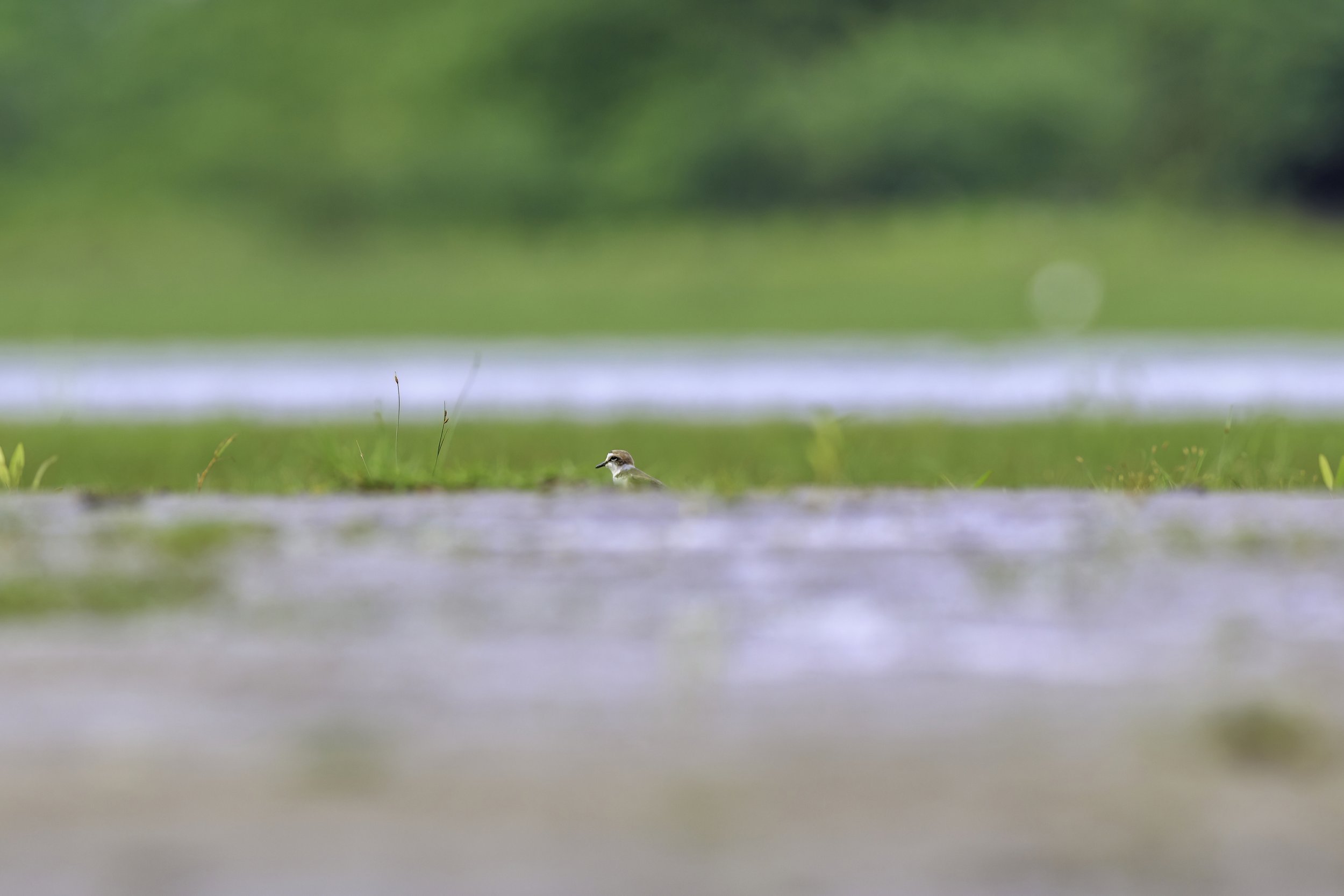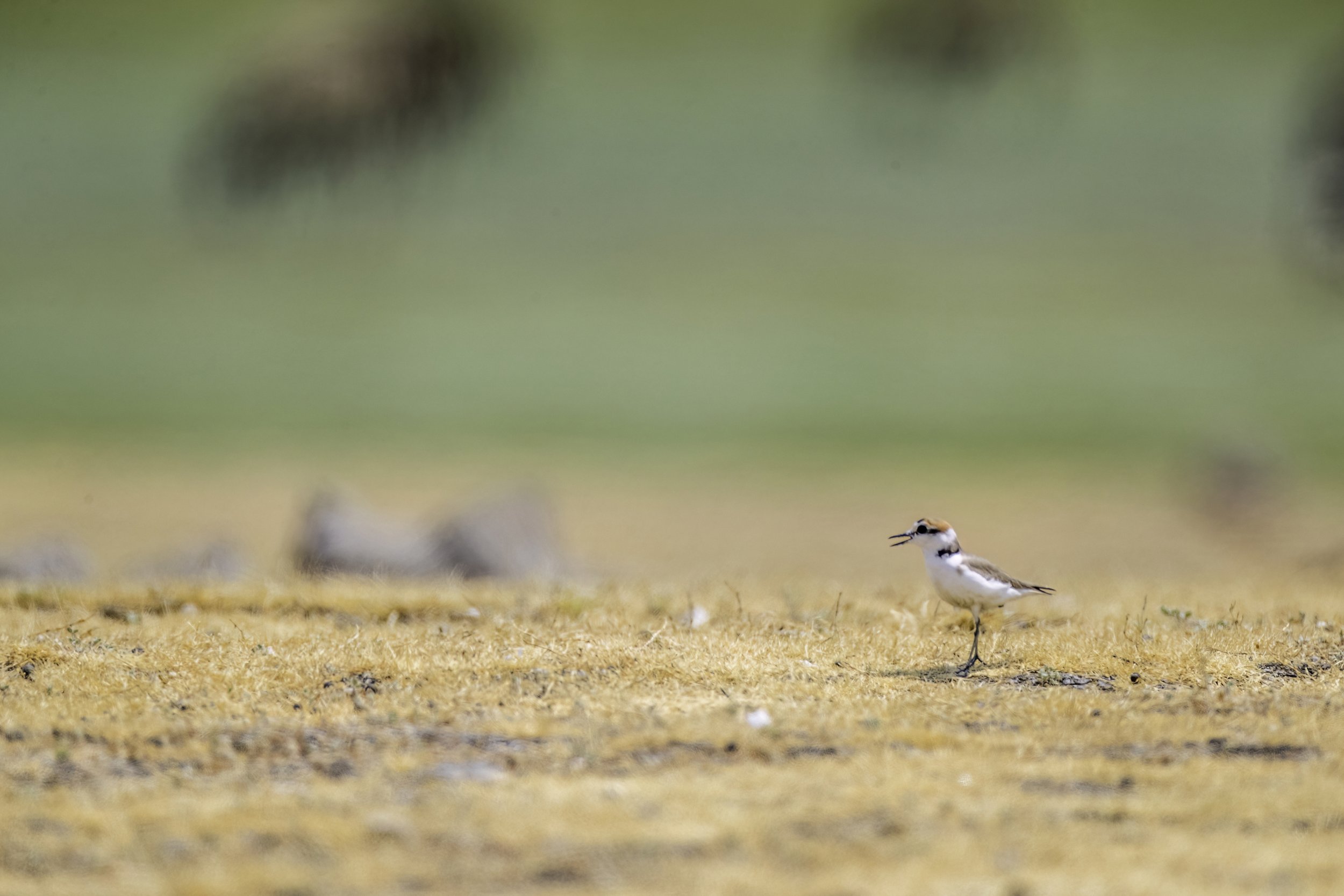Kentish Plover
Anarhynchus alexandrinus
Bhigwan Bird Sanctuary - Ujni Backwaters, Kumbhargaon & Bhairavapalem Mudflats, Coringa WLS
To the south of Bhigwan, bereft of any hills, lie the wide Ujni backwater wetlands. A shallow waste water reserve formed by the discharge of water from the Pune region dams like Panshet, Pawna, Khadakwasla, Varasgaon, Temghar, etc. This semi waste water has created an excellent wetland based ecosystem supporting a large variety of water birds, both endemic and migratory, and also helped with the local agriculture. Nearly 300 species of endemic and migratory birds have been recorded here. The rainfall in the Pune region decides the water level in Ujni dam. Lesser the water, the shallower it is and therefore more birds make it their home in the winter.
Surrounding this lush ecosystem are the rich grasslands and fertile farms home to an impressive list of birds, mammals and reptiles. The area around these backwaters are also unique with rich farmlands and dry deciduous scrub forest with interspersed grasslands. Home to an impressive list of birds, mammals and reptiles they protect many mammals like the Chinkara, Indian Mongoose, Near Threatened Striped Hyena, the Endangered Indian Grey Wolf & Indian Fox and are also popular for grassland birds and the birds of prey, including some magnificent eagles & harriers. My trip this time was focused only a few species like the Striped Hyena, Indian Grey Wolf and Jungle Cat. On our way back from the grasslands Ganesh said there was a Near Threatened Thick-knee & a Kentish Plover accessible at close quarters if one is careful. So we worked out how we would approach and got to the site. As we approached the plover after our time with the Thick-knee, it ran off some distance and watched us. With a lot of care I went to ground and made my way to a reasonable distance and waited for the plover to return. The plover watched Ganesh drive off and then slowly made his way back to his perch and gave me some beautiful moments with it.
From Right: Ganesh, Sandip Nagare & yours truly
But these water birds aren’t the only ones there, there are some magnificent eagles and harriers too like the Endangered Steppe Eagle, the Vulnerable Greater Spotted Eagle, the rare and Vulnerable Eastern Imperial Eagle & the Pallid Harrier, Montagu’s Harrier & Eurasian Marsh Harrier.
Apart from these there are other spectacular species like the Short-eared Owl, Spotted Owlets & the Indian Courser inhabiting the grasslands.
During my time here I was hosted by & had the expert help of Sandip Nagare and his team of knowledgeable guides from the Agnipankha Bird Watcher group, especially Ganesh Bhoi, who went out of their way to ensure I had fantastic opportunities to explore, discover, observe & photograph my target species on this trip like the Near Threatened Striped Hyena & Thick-knee. Like earlier, I stayed at Sandip’s homestay and once again had the added pleasure of indulging in delectable home cooked food.
Read about my birds from Kumbhargaon & the Bhigwan Bird Sanctuary here and watch the videos on my Youtube channel - WildArtWorks.
Kentish Plover
But that was a while back. This time what I saw was very alarming. The summers of the last two years have been harsh and the rains have been scanty leading to extensive evaporation and receding of the waterfront. My friend and local guide, Ganesh, said that the backwaters have receded almost two kilometers from where they used to be. I have here a couple of photographs of what used to be and what it is now. This exposed land is now used for cattle grazing and some degree of farming.

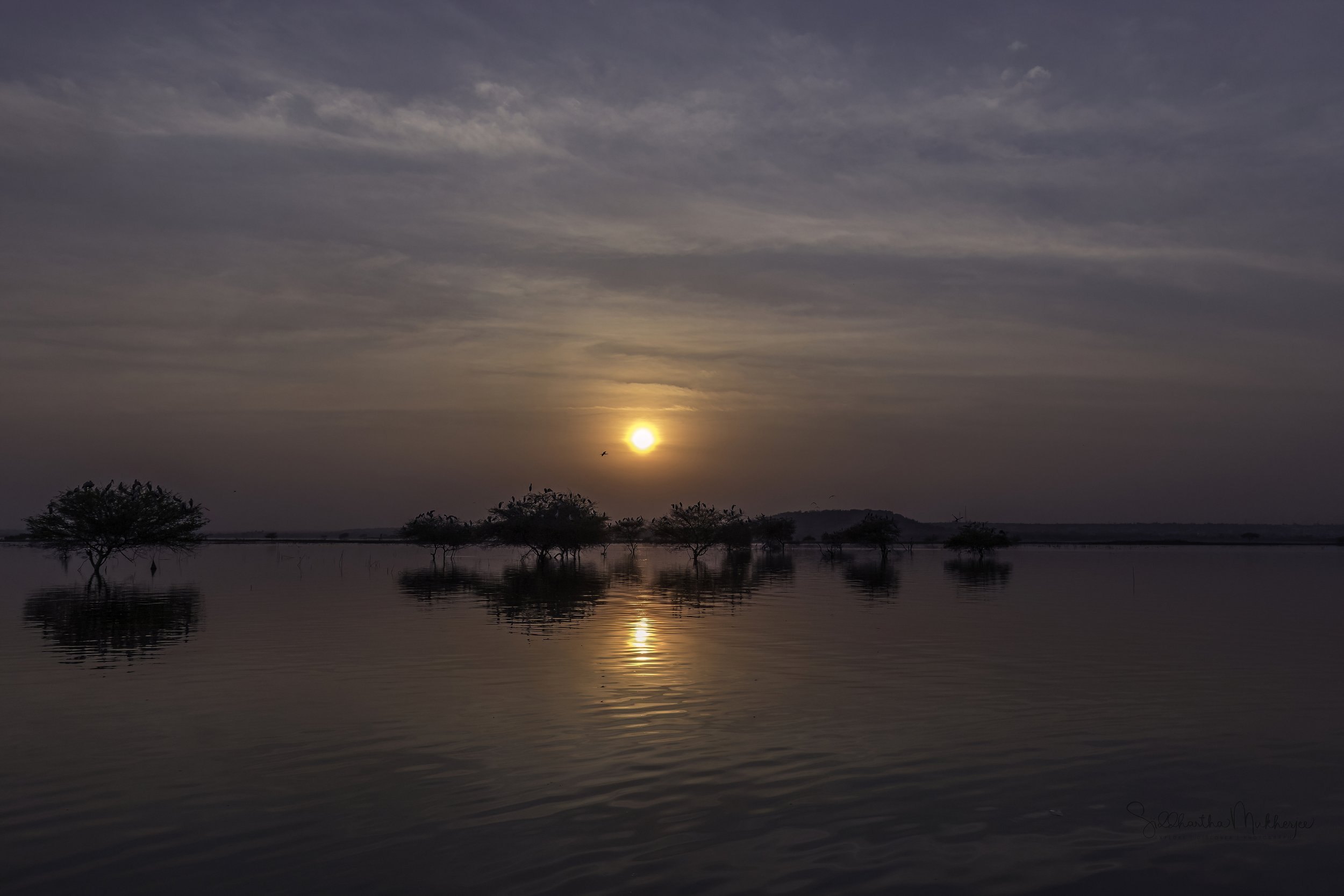
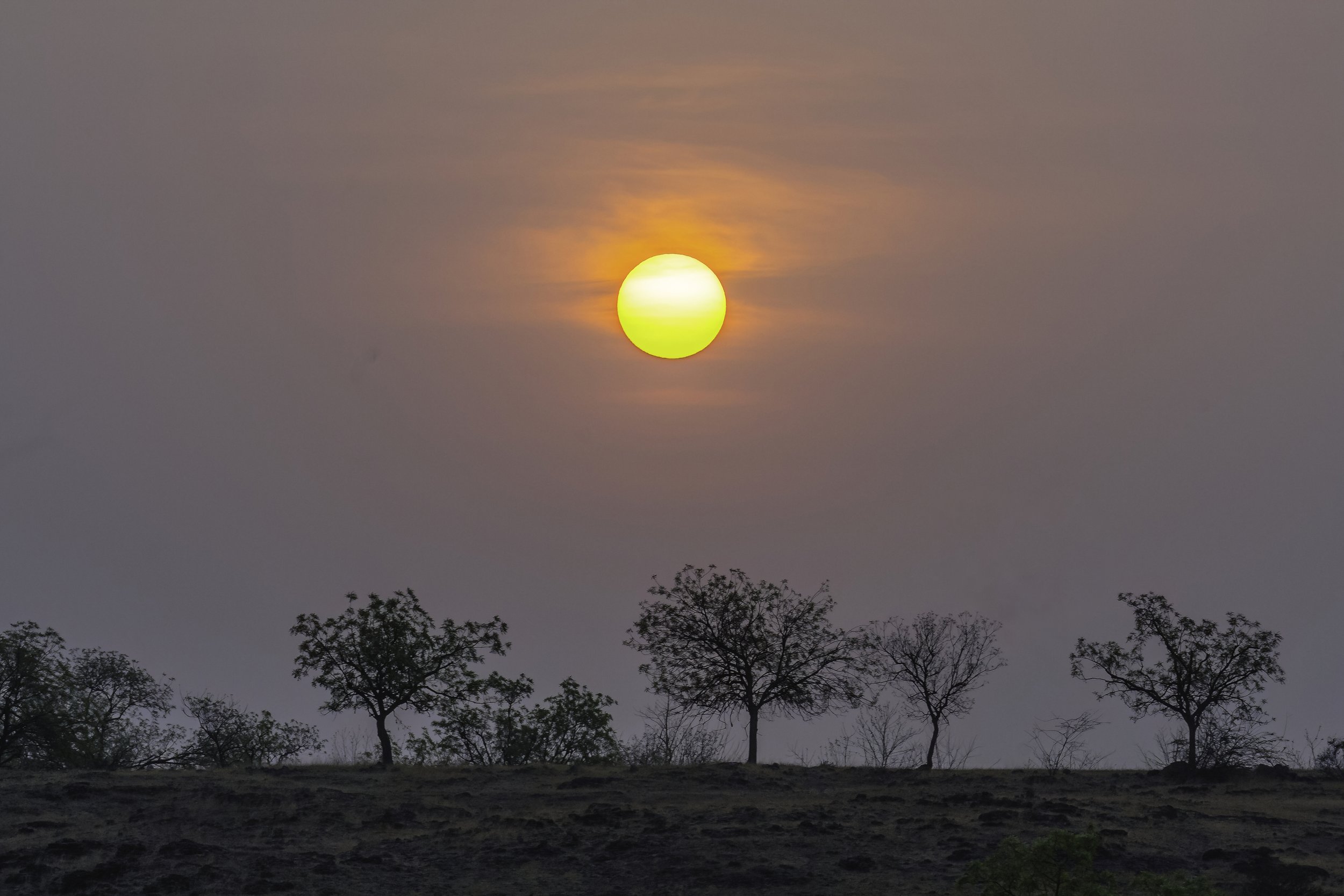
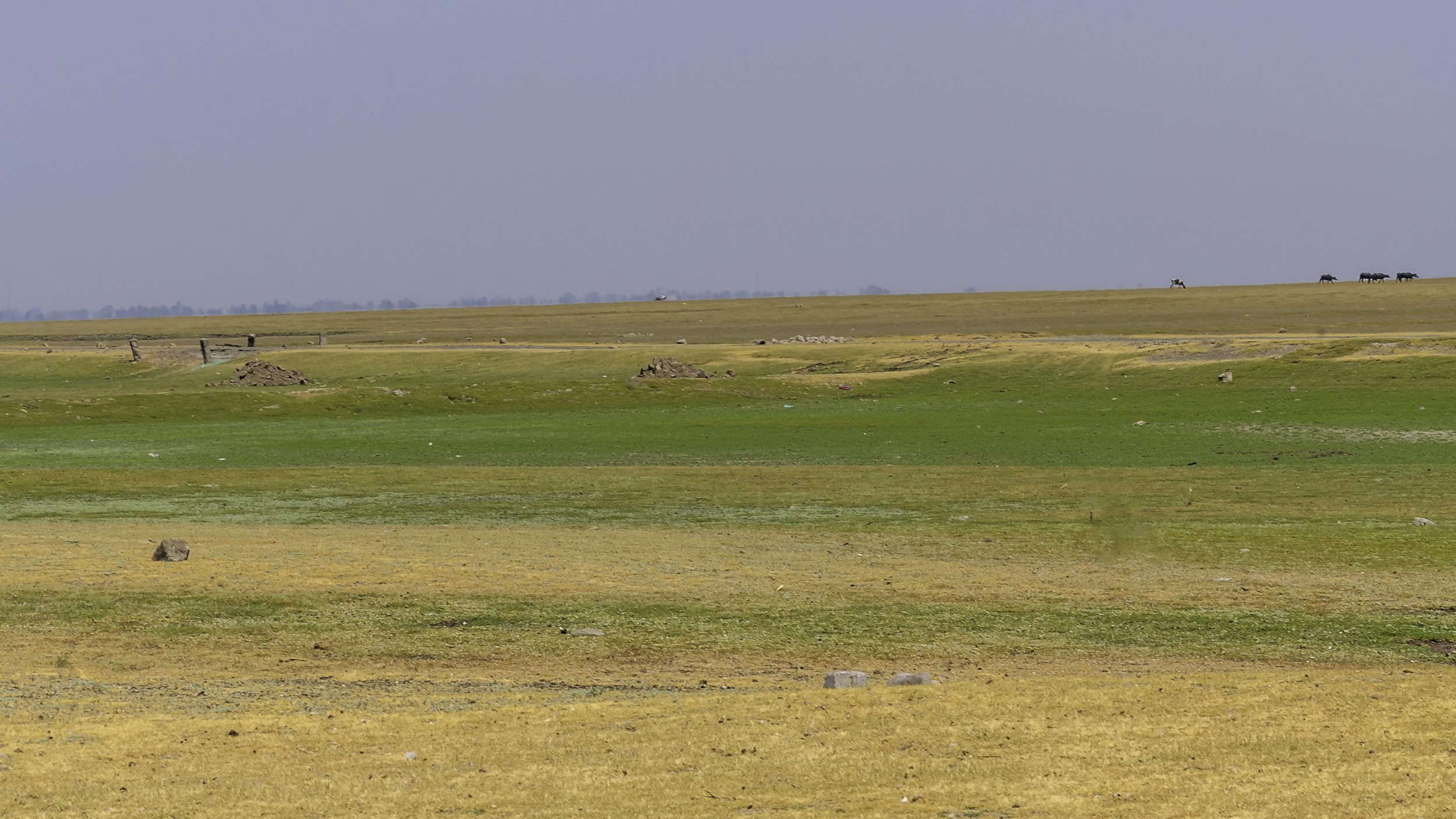
Ujni Backwaters, Bhigwan Bird Sanctuary
The Ujni or Ujjani Dam, also known as Bhima Dam or Bhima Irrigation Project, on the Bhima River, a tributary of the Krishna River, is an earth-fill cum Masonry gravity dam located near the Ujjani village of Madha Taluk in the Solapur district of the state of Maharashtra in India. The Bhima River, which originates in Bhimashankar of the Western Ghats, and forms the Bhima Valley with its tributary rivers and streams, has twenty-two dams built on it of which the Ujjani Dam is the terminal dam on the river and is the largest in the valley that intercepts a catchment area of 14,858 km² (which includes a free catchment of 9,766 km²). The construction of the dam project including the canal system on both banks was started in 1969 at an initial estimated cost of ₹400 million and when completed in June 1980 the cost incurred was of the order of ₹3295.85 million.
The reservoir created by the 185 feet high earth cum concrete gravity dam on the Bhima River has a gross storage capacity of 3.320 km³. The annual utilisation is 2.410 km³. The project provides multipurpose benefits of irrigation, hydroelectric power, drinking, and industrial water supply and fisheries development. The irrigation supplies benefit 500 km² of agricultural land, particularly in the Solapur district. Water supplied from the reservoir to irrigate agricultural areas primarily aims to reduce the incidence of famines and scarcity during drought conditions. The reservoir operation also lessens the threat due to floods to cities such as Pandharpur (an important religious pilgrimage centre for the Hindus). As a result of irrigation facilities, some of the important crops grown under irrigated conditions are sugarcane, wheat, millet and cotton.
This huge reservoir, almost seeming like a sea, is home to hundreds of birds - flamingos with their slender necks, egrets, painted storks, ruddy shelducks and many more. A man-made wetland, these backwaters are a winter sojourn of many migratory birds like the Brown-headed Gulls & Bar-headed Geese making it a mesmerising spectacle. This reservoir is one of the largest backwaters in India created by the Ujni dam. This life giving and sustaining reservoir fulfils multiple purposes - irrigation for agriculture, particularly in the Solapur district, being the primary one - but it also has rural, urban and industrial activities that are equally consuming.
Presently India has 26 sites designated as wetlands of International Importance according to Ramsar Convention. As far as Maharashtra goes, of its multiple natural and man-made reservoirs, none are designated as a Ramsar site. But according to Ramsar’s important identification criteria of population of migratory birds, the Ujni backwaters are amongst the six important wetlands of Maharashtra hosting around 250 species of migratory and resident birds ranging from the pied kingfisher, northern shoveler, bar-headed geese, great egret, painted stork, Indian cormorant, Eurasian coot, common moorhen, black-headed ibis, Asian open-bill, the list is pretty long.
With such a blessed habitat harbouring many species of flora and fauna, this wetland has tremendous benefits to the villages around it. Sufficient water for agriculture, livelihoods to many through fishing and tourism, flood control and shoreline stability are some of the aspects this wetland caters to. Though created strategically for economic development, today, the value of these wetlands function far beyond the scope of any instrument of economic growth.
But the modern day demands on this resource are tremendous. Cash crops requiring huge irrigation, unmonitored use of pesticides, untreated and excessive sewage and industrial waste disposals, uncontrolled urban growth and the changing mindsets of people for newer lifestyles are slowly and steadily affecting this huge wetland. Decline in the fish density in the major tributaries of River Krishna, increase in exotic weed species in water are some of the indicators of quality degradation of the wetland recorded by researchers. This isn’t the only threat to this spectacular habitat and its wildlife but it also has long term adverse effects on the present and future human population who are consumers of this wetland in the various ways they utilise it.
The conservation of such a large reservoir isn’t a simple task. It requires judicious water usage for local, agricultural and industrial purposes, advocating advanced irrigation technologies to avoid and minimise wastage and banning diversions of water for non-priority purposes can be some of the large-scale measures possible with equal participation of the Government and people alike. Conservation awareness among the local communities for wetlands and its flora-fauna can help in a long run.
On a smaller scale the villagers are doing their bit by consciously avoiding plastic litter, controlled fishing and adopting rowing instead of engines for tourist boats wherever possible. These are some of their simple but effective ways to stop draining these life giving wetlands.
Kentish Plover
The Kentish Plover is a small, pale plover with a broken black collar, sandy upperparts, grayish legs, and a rather fine black bill. In their breeding plumage they sport a black mask and black tabs at the sides of their breast (not a complete band). The non breeding plumages have black replaced by brown. They are a mainly coastal bird, often seen on sandy beaches, dry mudflats, and at salt ponds, usually near water; also locally inland. Migrants will join with flocks of other shorebirds. Both male and female birds have pale plumages with a white underside, grey/brown back, dark legs and a dark bill; however, additionally the male birds also exhibit very dark incomplete breast bands, and dark markings either side of their head, therefore the Kentish plover is regarded as sexually dimorphic.
The Kentish plover has a large geographical distribution, ranging from latitudes of 10º to 55º, occupying North Africa, both mainland, such as Senegal, and island, such as the Cape Verde archipelago, Central Asia, for example alkaline lakes in China, and Europe, including small populations in Spain and Austria. Some populations are migratory and often winter in Africa, whereas other populations, such as various island populations, do not migrate. Its common English name comes from the county of Kent, where it was once found, but it has not bred in Britain since 1979.
Kentish plovers are ground-nesting birds, often with a preference for low, open, moist nesting sites away from thick vegetation and human activity. They use a number of materials to build their nests, mainly consisting of shells, pebbles, grass and leaves in a small scrape in the ground. Like most plovers, the Kentish plovers are predominantly insectivores, feeding on a large range of arthropods and invertebrates depending on the environment, by using a run and stop method.
The Kentish plover was formally described in 1758 by Carl Linnaeus in the tenth edition of his Systema Naturae under the binomial name Charadrius alexandrinus. Linnaeus based his account on the description of a bird from Egypt by the Swedish naturalist Fredrik Hasselqvist that had been published in 1757. In 1801 the ornithologist John Latham coined the binomial name Charadrius cantianus for the species (now a junior synonym) and introduced the English name "Kentish Plover" as his specimens had been shot near the town of Sandwich in Kent. A molecular phylogenetic study published in 2022 found that Charadrius was paraphyletic. The genus was therefore split and a clade that included the Kentish plover was moved to the genus Anarhynchus that had previously only contained the wrybill.
The North American snowy plover was formerly treated as a subspecies of the Kentish plover. However, a study published in 2009 found that they were in fact distinct enough to be treated as separate species. In 2023 it was proposed that the subspecies seebohmi of southern India and Sri Lanka should be elevated to full species status. The English name of Hanuman Plover was suggested based on the mythology of the monkey god Hanuman who built a bridge between India and Lanka in the epic Ramayana.
Three subspecies are recognised:
A. a. alexandrinus (Linnaeus, 1758) – coastal west Europe (formerly British Isles), Macaronesia (west of northwest Africa), north Africa, sporadically to Senegal; inland through central Asia to northwest, central north Indian subcontinent, north, central Mongolia and north China
A. a. nihonensis (Deignan, 1941) – Sakhalin and Kuril Islands (southeast Russia), Hokkaido through Ryukyu Islands, Korea Peninsula, northeast, east China and Taiwan
A. a. seebohmi (Hartert, EJO & Jackson, AC, 1915) – south India and Sri Lanka
The Kentish plover is a small shorebird weighing around 40 g as an adult. Both male and female birds have black bills and dark legs, however adults have dimorphic plumage. During the breeding season, males have a black horizontal head bar, two incomplete dark breast-bands on each side of their breast, black ear coverts and a rufous nape and crown (although there is some variation between breeding populations), whereas the females are paler in these areas, without the dark markings. In the early breeding season, it is easy to distinguish between males and females since the ornaments are very pronounced, but as the breeding season progresses, the differences between the two sexes decrease. Moreover, males have longer tarsi and longer flank feathers than females. Longer flank feathers are thought to be an advantage for incubation and brood care, as the quality of feathers is associated with heat insulation. There are multiple significant predictors of plumage ornamentation in Kentish plovers. Firstly, the interaction between the advancement of the breeding season and rainfall seem to affect ornamentation. Male ornaments become more elaborated over the course of a breeding season in regions with high rainfall, whereas in regions with low rainfall, male ornaments become lighter. Secondly, the interaction between the breeding system and the sex can predict the degree of plumage ornamentation. In polygamous populations, the sexual ornaments are more pronounced, generating a stronger sexual dimorphism than in monogamous populations. The difference is especially witnessed in males, whereby the ornaments are darker and smaller in polygamous populations compared to monogamous populations, where males have lighter and larger ornaments. This is thought to be the result of a trade-off between the size and intensity of the ornaments.
Kentish plovers have an extremely wide geographical distribution and their habitats vary not just spatially but environmentally too. They are known to reside and breed in multiple types of habitat, from desert with ground temperatures reaching 50 °C to tundra. The distribution of this species' breeding areas covers Europe, Asia and Africa. In Europe, populations are typically found in the west; although there was once a breeding population in Hungary, Kentish plovers no longer breed there. In Africa, populations are found on the southern coast of Senegal and along the Northern coast of the Mediterranean, and the Red Sea coast. The breeding area continues along the Arabian Peninsula, Saudi Arabia, Qatar, and Bahrain in the Middle East. Small populations can be found on islands too, such as the Cape Verde archipelago, the Canary Islands, and the Azores. It is a rare vagrant in Australia. Some populations do not migrate, such as the Maio (Cape Verde) population, however other populations can migrate reasonable distances, for example, plovers that spend winter in North Africa have been known to migrate to Turkey and Greece in the spring. Some birds breeding in western Europe are not known to travel very far, just within Europe, however some do travel, mainly to Western Africa.
The breeding habitats are most commonly alkali lake shores, wetlands, salt marshes, and coastland, which is fitting with the results of a study that investigated what makes an environment suitable for a breeding habitat for the Kentish Plover. By analysing four variables of all known nests, the study found that plovers prefer to nest in areas of low elevation, low vegetation, high moisture and places faraway from human activity and settlements. There have been observations of parents moving their chicks from poor food areas to better food areas, with chicks subsequently growing stronger in the high food areas. This suggests that parents strategically move their chicks and change habitats. Moving young has benefits: protection from predators, obtaining more food, avoiding competition for food and space, avoiding potential infanticide due to competition, and avoiding territory defences from others.
The Kentish plover has an especially flexible breeding system, including both monogamous and polygamous behaviours within populations. It is known that breeding pairs return to breed with each other the following year, however mate changes have also been observed both between and within breeding seasons. Kentish plovers inhabit sandy areas or salt-marshes in close proximity to water. Inland populations can be found near alkaline or saline lakes, ponds or reservoirs. The populations inhabiting the coastal regions can be found in semi-desert habitats i.e. on barren beaches, near lagoons and sand extractions on beaches or dunes. Kentish plovers are territorial shorebirds; the male usually has a territory and attracts females with courtship displays. The parents are actively defending their nest territories from predators by chasing, fighting or posturing them. When approached by predators in close proximity to the nest, the Kentish plovers quickly run away from the nest and start doing distraction displays to focus the predator's attention on themselves and lure them away from the nest. These displays include calling or crawling on the ground flapping their wings. Males tend to be more aggressive than females, but females performing riskier defensive behaviours than males. When a plover's territory has been invaded, it invades a neighbouring family's territory. This is when fights between males frequently occur because the plovers see their broods threatened. During such fights, it occurs that chicks get injured or even killed. When approached by a predator, chicks usually try to find a spot where they can hide, crouch down and stay motionless to remain unseen. When they are older, they try to run away with their parents.
Kentish plovers either nest solitarily or in a loose semicolonial manner. They are ground-nesting birds that lay their eggs in small shallow scrapes prepared by the male during courtship on the bare ground. Selection of the breeding ground is essential for the survival of nests and broods; nests are placed near the water on bare earth or in sparse vegetation; often on slightly elevated sites in order to have a good view of the surroundings to spot predators from a distance or near small bushes, plants or grass clusters, where the eggs are partly sheltered from predators.
Parental care is variable within birds and the Kentish plover has a slightly different mechanism to other shorebirds. Both parents incubate the eggs, however both parents do not always stick around once the eggs have hatched. It is not unusual for one parent to leave the chicks after a variable amount of time; this is referred to as brood desertion. Brood desertion is the ‘termination of care, by either one or both parents, before the offspring are capable of surviving independently’ and usually occurs after one week of the brood being accompanied by both parents. Brood desertion has been observed in both males and females, however females desert the brood significantly more frequently than males.
The alarm call, referred to as kittup call, is often heard both on the ground and in the air and can occur on its own, or paired with a tweet, heard as too-eet. The threat note is described as a "twanging, metallic, dwee-dwee-dweedweedwee sound".
The Kentish plover is classified as least concern on the Red List because it has a very large population range. The global population size of the Kentish plover is continuously declining although for some populations the trends are unknown. The European population is estimated at 43,000-70,000 individuals, forming around 15% of the global population (estimated at 100,000-500,000 individuals). A major threat to this species is habitat loss and disturbance. Human activity such as tourists walking through protected areas, pollution, unsustainable harvesting and urbanisation can destroy nesting sites. Plover populations can also be affected by rural human activity, for example fishermen walking through protected plover breeding sites, bringing large numbers of dogs with them - a known predator of plover eggs. Breeding birds respond to human disturbance disproportionately when dogs are present, as these situations are interpreted in a context of greater risk of predation. Natural predators are also a problem, as many of these predators appear to thrive unnaturally well in the presence of plover breeding grounds, such as the brown-necked raven (Corvus ruficollis) in Maio, Cape Verde, the White-tailed Mongoose (Ichneumia albicauda) in Saudi Arabia, and the Grey Monitors (Varanus griseus) in Al-Wathba Wetland Reserve. It is thought that the high amount of prey available to these predators attracts them into the breeding grounds- an effect named the 'honey pot', Global warming and climate change also plays a role in the decline of areas available for plovers to breed and reside in. It is known that the Kentish plover prefers to build its nests on low-elevated land close to water, and a study untaken in Saudi Arabia discovered that 11% of nests in the study site were in fact below sea level, therefore rising sea levels are predicted to have disastrous consequences for these low-sitting nests.
Related Posts

